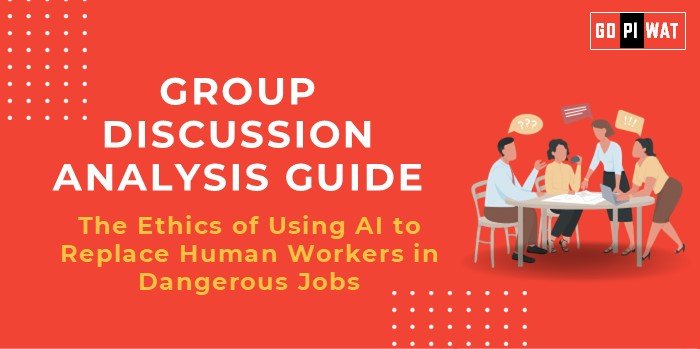📋 Group Discussion (GD) Analysis Guide
Topic: The Ethics of Using AI to Replace Human Workers in Dangerous Jobs
🌐 Introduction to the Topic
Opening Context: The rapid adoption of AI technology in hazardous industries such as mining, construction, and chemical manufacturing is transforming traditional labor paradigms. While AI minimizes human risk exposure, it raises ethical concerns about job displacement and economic implications.
Topic Background: AI’s potential to revolutionize industries stems from its efficiency and precision. Its use in dangerous environments aims to safeguard human lives. However, questions arise regarding the ethical implications of replacing human workers, especially in economies dependent on manual labor.
📊 Quick Facts and Key Statistics
- Workplace Fatalities (Global): Over 2.8 million workplace deaths annually (ILO, 2024), highlighting the need for safer alternatives.
- AI Adoption in Hazardous Industries: 35% growth in AI usage in high-risk sectors (2023).
- Job Displacement Estimates: Up to 14 million jobs in high-risk sectors could be replaced by automation by 2030 (WEF).
- Cost Reduction with AI: 25-30% lower operational costs in dangerous jobs due to reduced risk and increased efficiency.
👥 Stakeholders and Their Roles
- Governments: Policy regulation, job reskilling programs, and labor rights protection.
- Corporations: Investment in AI technology and ensuring fair worker transitions.
- Employees and Unions: Advocacy for displaced workers and reskilling opportunities.
- Technology Developers: Ethical AI design ensuring transparency and accountability.
🎯 Achievements and Challenges
Achievements:
- Reduced Fatalities: AI deployment in mining reduced accident rates by 30% (2023, McKinsey).
- Enhanced Productivity: Increased efficiency in dangerous sectors by 40%.
- Cost Savings: Significant reductions in operational risk insurance premiums.
Challenges:
- Economic Displacement: Millions of workers face job loss without clear reskilling pathways.
- Ethical Concerns: Decision-making by AI in life-threatening situations is morally ambiguous.
- Technological Gaps: Limited AI reliability in unpredictable, high-stakes environments.
🌍 Global Comparisons:
- China: Pioneered AI in manufacturing, but faces public resistance due to job cuts.
- Norway: Successfully integrated AI in oil rigs, balancing human oversight and safety.
📂 Case Studies:
- Rio Tinto’s Autonomous Trucks: Reduced mining incidents but displaced local workers.
- Amazon Warehouses: AI-driven robots cut costs but faced backlash over job reductions.
📚 Structured Arguments for Discussion
- Supporting Stance: “AI ensures human lives are not put at risk in high-stakes environments like deep-sea mining and nuclear plants.”
- Opposing Stance: “Replacing human workers with AI leads to economic disparity and neglects the social value of human labor.”
- Balanced Perspective: “While AI improves safety, its implementation must be coupled with ethical considerations for displaced workers.”
✨ Effective Discussion Approaches
- Opening Approaches:
- Impactful Statistic: “2.8 million annual workplace deaths underscore the need for AI in hazardous industries.”
- Ethical Dilemma Framing: “Can safety gains from AI outweigh the societal costs of job losses?”
- Counter-Argument Handling:
- Recognize concerns about job displacement; propose worker reskilling programs funded by AI-driven cost savings.
🔑 Strategic Analysis of Strengths and Weaknesses
Strengths:
- Enhanced safety, cost efficiency, and technological advancement.
Weaknesses:
- Economic inequity, societal resistance, and ethical complexities.
Opportunities:
- Reskilling programs, AI-human collaboration, global leadership in ethical AI.
Threats:
- Regulatory pushback, technological misuse, and widening inequality gaps.
🔗 Connecting with B-School Applications
- Real-World Applications: AI-based operational models, labor management frameworks, and CSR initiatives in worker reskilling.
- Sample Interview Questions:
- “How can businesses ethically balance safety and employment in hazardous sectors?”
- “What role can AI play in promoting inclusivity in industries?”
- Insights for B-School Students:
- Ethical AI deployment can become a core management challenge.
- Companies need innovation strategies to merge AI with human oversight effectively.


